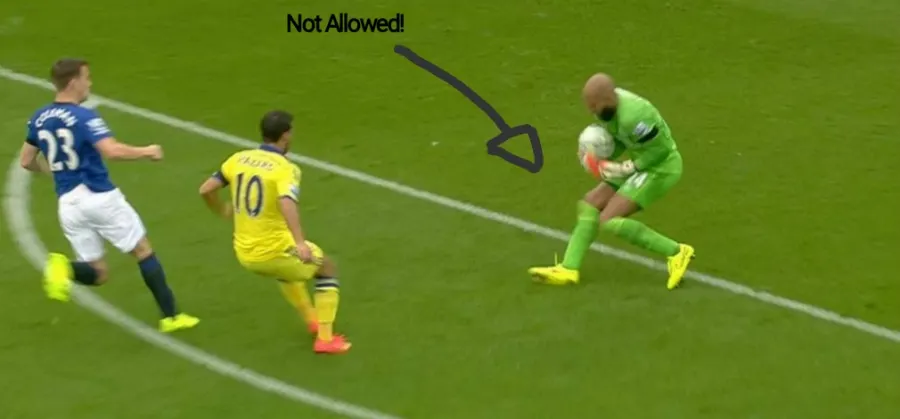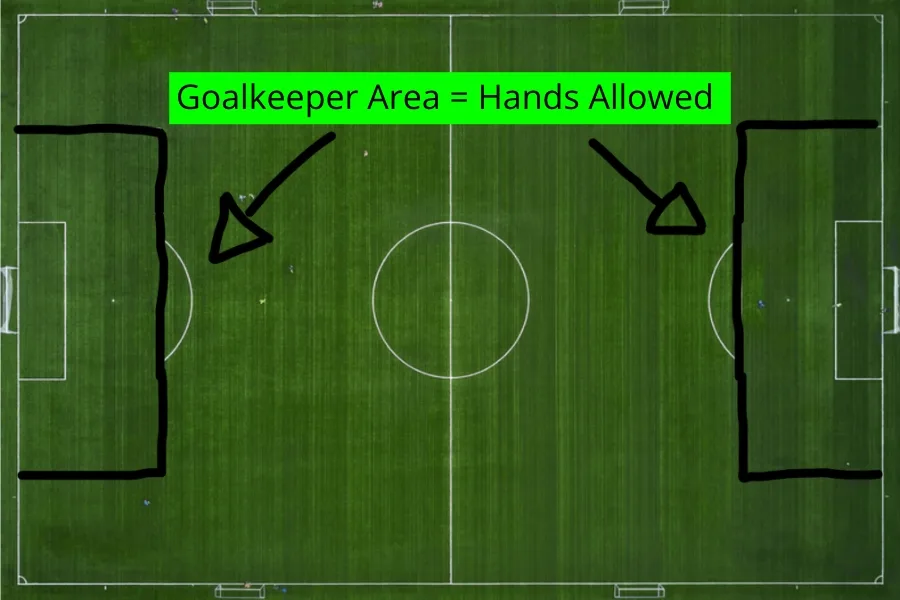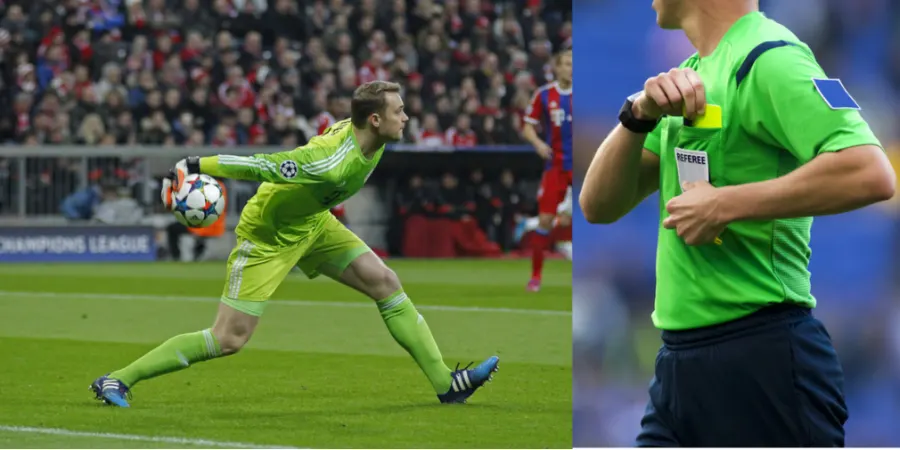
The goalkeeper position is one of the most challenging roles in soccer and one of the hardest places to be when you’re having a bad game.
Unlike an outfield player, the goalie has nowhere to hide if things aren’t going their way. The one advantage a goalkeeper has is that they’re able to use their hands, but even that perk has certain limitations.
Today, we’re going to look at when a goalkeeper can’t use their hands, when these situations arise, and how a goalkeeper has to adapt to maintain an edge. If your goalkeeper never leaves their six-yard box, you’ve nothing to worry about.
Modern goalkeepers now have to be adaptable enough to move around freely, even outside their own penalty area, leading them into situations where they’re uncomfortable and can’t use their hands.
After reading this article, the next time you see your goalkeeper get a yellow card, you’ll know why and how they could have avoided it.
A goalkeeper can’t use their hands in the following situations:
- Outside The Penalty Area
- The Opponent’s Penalty Area
- Throw Ins From Your Own Team
- Backpass To The Goalkeeper
- The Six-Second Rule
Outside The Penalty Area

Unsurprisingly, goalkeepers can only handle the ball inside their penalty area. However, the goalie can be outside the area when they touch the ball with their hands as long as the ball remains inside.
Here’s the goalkeeper area – where a goalkeeper is allowed to use their hands:

On the occasions when the goalkeeper does venture outside their safety zone, they must only use their feet or body to block a shot.
With the emergence of the sweeper keeper, we’ve started to see many more goalkeepers head upfield with the ball, allowing their teammates to move ahead of them.
As well as freeing up players for the goalkeeper to initiate attacks, sweeper keepers are more susceptible to being caught with the ball at their feet.
If the goalie does lose the ball outside their area, their first response is to immediately retreat into the area so that they can again use their hands to stop the ball from going into the net.
If it’s impossible to get back into position before the opponent shoots, the only option is to either accept that a goal will be scored or try to block the shot with their body or feet instead.
The Opponent’s Penalty Area
As tempting (and fun) as it is for a goalkeeper to head into their opponent’s penalty area, it’s usually only seen when a team needs a last-gasp goal that you’ll see the goalie bombing forwards for a corner.
There are many examples of goalkeepers scoring, too, defenders aren’t expecting to have to mark a goalie, and as most goalkeepers are tall, they’re a handy goal threat.
What can’t happen is that the goalkeeper can use their hands in their opponent’s area. If the goalkeeper does handle the ball, a direct free kick is awarded to the other team, and the keeper gets a caution.
Throw Ins From Your Own Team

While a goalkeeper can and will roam out of their penalty area at times, especially to close down a through ball in order to kick it away, their role is to stay as close to the goal as possible.
Preventing the opponents from scoring, using any body part they want, including their hands, a goalie can only catch the ball in their own penalty area.
One of the only times a goalkeeper can’t use their hands is when a teammate gets the ball for a throw-in and throws the ball directly back to the goalkeeper.
Until 1997, outfield players could throw the ball back to their goalie, relieving pressure on the team, but to speed up the game, this rule was abolished to make it more exciting for fans.
Backpass To The Goalkeeper
If you’ve ever watched replays of soccer games from before 1992, you’ll see that many games had players passing the ball back to their goalkeeper, only for the goalie to then pick up the ball.
In the modern game, this is unheard of, and it’s all thanks to the back-pass rule that was introduced in the wake of the 1990 World Cup.
The back-pass rule is designed to speed up the game and make it more interesting to watch; pre-1992 games were littered with repeated passes to goalkeepers, which slowed the games down considerably.
In the 1990 World Cup finals in Italy, during the Republic of Ireland versus Egypt game, the Irish goalkeeper held the ball for an astonishing boring six minutes.
Here’s a clip showing how problematic it was, and why eventually the back-pass rule was introduced:
While that example is extreme, many games were stop-start affairs that had the defender pass to the goalkeeper, who then passed to the defender, who then passed it back for the goalie to pick up.
It was as gloomy to watch as it is to read about, and the introduction of the pass-back rule was widely lauded.
The rule was also the catalyst for the sweeper keeper, a ball-playing goalkeeper with the technical skills to play with the ball at their feet. It also made games much faster and infinitely more exciting to watch.
It also puts much more pressure on teams to clear their lines rather than look to the goalkeeper as a safety net.
Players have found certain tricks to try and circumvent the back-pass rule, including flicking the ball into the air and then heading it back to the goalkeeper, but the authorities quickly stamped down on this.
An outfield player can accidentally deflect the ball back to the goalie or block the ball with their body, and the goalie can then pick up the ball, but any suspicion that a ball has been passed back can result in a direct free kick to the opponents.
The Six-Second Rule

As well as not being able to pick up the ball from a pass-back or throw-in, goalkeepers are also penalized if they hold on to the ball for too long.
The six-second rule is rarely used by referees, but should a goalkeeper hang on to the ball for too long, the referee warns them to get on with the game quickly.
If the goalkeeper keeps holding the ball, the opposition team gets an indirect free kick and the goalie may receive a yellow card.
Introduced as part of the reforms to make soccer more entertaining for spectators and TV viewers, it’s now rare to see a goalkeeper hang on to the ball for very long.
A goalie can hold onto the ball for 6 seconds and then drop it to their feet to play a pass, but they aren’t allowed to pick the ball back up if a striker closes them down.
A risky way around dropping the ball and not being allowed to pick it back up again is to kick the ball against an opposition player and then catch the ball, but it’s risky, to say the least.
If a goalkeeper that has dropped the ball suddenly finds themselves in serious trouble, they’ll usually kick the ball out into touch for a throw-in to alleviate the pressure on their goal.
Conclusion
Being a goalkeeper is a lot more complex than first meets the eye; it’s not just about getting in the way of the ball.
A modern goalkeeper has to create chances and navigate the specific rules set down for goalies, control their defense, and ensure they don’t get sent off for an infraction of the rules.
Every mistake is magnified so that whereas an outfield player can make a mistake and there are no repercussions, a goalkeeper that handles outside their area is instantly dismissed by the referee.
Time on the ball is restricted, and a pass back from a teammate can be a catastrophe for the goalkeeper, but if a poor back-pass leads to a goal, it’s at the keepers’ feet the blame is laid.
You can learn more about the handball rules in this article.
